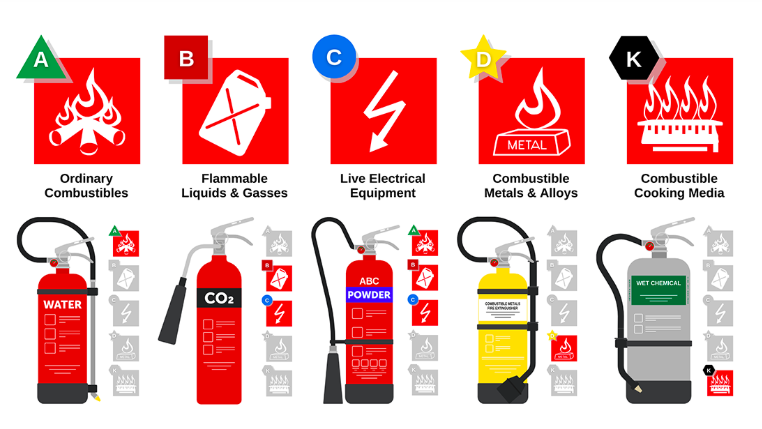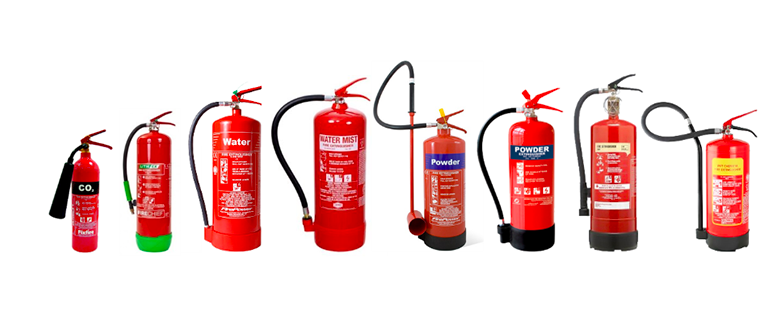

Fire safety isn’t just a legal requirement; it’s a critical investment in protecting your people, property, and business continuity. One of the most fundamental elements of any fire safety plan is having the correct type of fire extinguisher readily available and accessible. Using the wrong extinguisher on a fire can be ineffective at best and catastrophically dangerous at worst.
At FiresafePlus.com, we understand the complexities of fire safety equipment. As a trusted fire extinguisher supplier, we help businesses worldwide navigate regulations and select the optimal solutions. This guide breaks down the main types of fire extinguishers, their uses, and how to choose the right one for your specific environment.
Understanding Fire Classes: The Foundation
Fires are classified based on the fuel source. Matching the extinguisher type to the fire class is paramount:
Class A: Fires involving ordinary combustibles like wood, paper, cloth, rubber, and many plastics. (Think: office furniture, warehouse stock, textiles).
Class B: Fires involving flammable liquids such as gasoline, oil, grease, paints, solvents, and propane. (Think: workshops, garages, kitchens, chemical storage).
Class C: Fires involving energized electrical equipment like appliances, wiring, circuit breakers, and outlets. (Crucially, once the electricity is OFF, it may revert to Class A or B). (Think: server rooms, control panels, workshops).
Class D: Fires involving combustible metals like magnesium, titanium, potassium, and sodium. (Primarily industrial settings).
Class K (or Class F): Fires involving cooking oils and fats, typically in commercial kitchens. (Think: restaurants, cafeterias).
The 5 Main Types of Fire Extinguishers & Their Uses
Dry Powder Fire Extinguishers (ABC or BC Ratings):
How they work: Smother the fire by interrupting the chemical reaction.
Good for: Class A, B, and C fires (ABC type) or just B & C (BC type). Versatile and common.
Ideal for: Workshops, garages, vehicles (boats, RVs), general industrial areas, boiler rooms. Excellent for mixed risk environments.
Considerations: Creates significant mess (powder residue) that can damage sensitive electronics. Reduced visibility during use. Not suitable for confined spaces without ventilation.
Keywords:
dry chemical extinguisher,ABC extinguisher,multipurpose fire extinguisher.
CO2 Fire Extinguishers (Carbon Dioxide):
How they work: Displaces oxygen and cools the fire rapidly.
Good for: Primarily Class B and Class C fires (flammable liquids & electrical fires).
Ideal for: Offices with significant electrical equipment (computers, servers), laboratories, printing rooms, electrical panels, flammable liquid storage areas. Leaves no residue.
Considerations: Limited effectiveness outdoors (wind disperses gas). Risk of cold burns from the discharge horn. Not suitable for Class A fires (doesn’t cool deep-seated embers). Can reduce oxygen levels in confined spaces.
Keywords:
CO2 extinguisher,carbon dioxide fire extinguisher,electrical fire extinguisher.
Foam Fire Extinguishers (AFFF – Aqueous Film Forming Foam):
How they work: Forms a film that cools the fire and seals the fuel surface from oxygen, preventing re-ignition.
Good for: Class A and Class B fires (especially effective on liquid fires).
Ideal for: Warehouses, garages, workshops, fuel storage areas, airports. Effective on liquid spills.
Considerations: Can be conductive, so not safe for energized electrical fires (Class C) unless specifically rated for it. Requires cleanup after use. Environmental considerations exist with older foam types (PFAS), though newer, more environmentally friendly formulations are available.
Keywords:
foam fire extinguisher,AFFF extinguisher,liquid fire extinguisher.
Water Fire Extinguishers (With Additives):
How they work: Cools the burning material below its ignition point. Often contain additives to reduce surface tension, improving penetration.
Good for: Class A fires ONLY (ordinary combustibles).
Ideal for: Offices, schools, libraries, retail stores, hotels – areas with predominantly paper, wood, fabric.
Considerations: NEVER use on Class B (flam liquids – spreads fire), Class C (electrical – electrocution risk), Class D, or Class K fires. Can cause water damage. Freezing risk in cold environments unless antifreeze added.
Keywords:
water fire extinguisher,Class A extinguisher,water mist extinguisher.
Wet Chemical Fire Extinguishers:
How they work: Reacts with burning cooking oil/fat to form a soapy layer (saponification), cooling the surface and sealing out oxygen. Often includes a fine mist for cooling and preventing splashing.
Good for: Primarily Class K (Class F) fires (cooking oils/fats). Often rated for Class A fires as well.
Ideal for: Commercial kitchens (restaurants, hotels, cafeterias), food processing areas. Essential for deep fat fryers.
Considerations: Specifically designed for high-temperature cooking fires. Not suitable for other liquid fires (Class B) unless specifically rated.
Keywords:
wet chemical extinguisher,Class K extinguisher,kitchen fire extinguisher.
Choosing the Right Fire Extinguisher for Your Business: Key Factors
Identify the Primary Fire Risks: What materials are present? (Wood, paper, flammable liquids, electrical gear, cooking oils?). Conduct a thorough fire risk assessment.
Match Extinguisher Type to Fire Classes: Ensure the extinguishers you select are rated for the specific fire classes identified in your risk assessment.
Consider the Environment: Size of the area, presence of sensitive equipment (requiring clean agents like CO2 or newer clean powder formulations), ventilation, temperature extremes.
Compliance with Local Regulations: Adherence to standards like NFPA 10 (USA), BS EN3 (Europe/UK), AS/NZS 1841 (Australia/NZ) is mandatory. Regulations dictate type, size, placement, number, and maintenance requirements. (This is crucial for your export market – highlight your understanding of international standards!)
Ease of Use & Training: Ensure staff can physically handle the extinguisher size/weight and are trained on its proper use for the specific risks in their area.
Maintenance & Servicing: Regular inspections and maintenance by qualified personnel are essential for reliability. Factor this in.
Partner with a Reliable Fire Extinguisher Supplier
Selecting and maintaining the right fire safety equipment is critical. Partnering with an experienced fire extinguisher supplier like FiresafePlus.com ensures you get:
High-quality products meeting international standards (
EN3,UL,CE, etc.).Expert guidance on selecting the correct types of fire extinguishers (
dry powder extinguisher,CO2 extinguisher,foam extinguisher,water extinguisher,wet chemical extinguisher) for your specific needs.Compliance support for various regional regulations.
Reliable global export logistics.
Ensure Your Business is Protected. Choose Wisely.
Don’t leave fire safety to chance. Understanding the different types of fire extinguishers and carefully choosing the right fire extinguisher for each area of your facility is a cornerstone of effective fire protection. Review your fire risk assessment today and ensure your extinguishers are up to the task.
Ready to equip your business with the right fire extinguishers? Explore our range of certified Dry Powder, CO2, Foam, Water, and Wet Chemical Fire Extinguishers at FiresafePlus.com and contact us for expert advice tailored to your needs and location.
